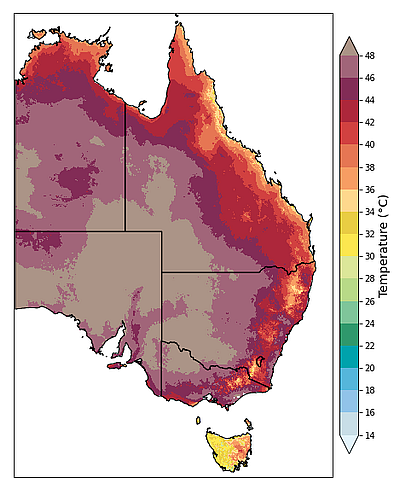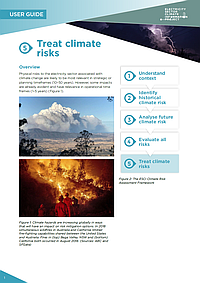Climate Change in Australia
Climate information, projections, tools and data
Step 5: treat climate risks
DownloadGuidance Step 5
(pdf 1.9 MB)
Overview
Physical risks to the electricity sector associated with climate change are likely to be most relevant in strategic or planning time frames (10–50 years). However, some impacts are already evident and have relevance in operational time frames (1–5 years).
The ESCI climate risk assessment framework (Figure 1) takes a decision-centred approach and is aligned with International Standard ISO 31000. Step 5 assumes that the climate risk has been assessed, evaluated and prioritised in the context of other risks (Step 4 of the ESCI Climate Risk Assessment Framework) and involves the assessment of risk treatment options. Risk treatment includes mitigation or adaptation and should result in lowering the impact of the risk on the system or process or reducing the chance of occurrence.
Every risk treatment option will have associated costs and benefits which will be assessed against the National Electricity Objectives:
To promote efficient investment in, and efficient operation and use of, electricity services for the long-term interests of consumers of electricity with respect to:
- price, quality, safety and reliability and security of supply of electricity
- the reliability, safety and security of the national electricity system
Risk mitigation or adaptation is measured as improvements in reliability, savings in capital costs, savings in operating costs, benefits for customers or benefits to the environment. For example, the metric for assessing effective risk treatment may be the improvement to system reliability in a region experiencing reduced network capacity resulting from increasing temperatures.
The cost-benefit analysis and modelling required to justify investment will be different for different electricity sector organisations; some parts of the sector will need to satisfy regulatory requirements.

Figure 1 The ESCI Climate Risk Assessment Framework.
CONSIDERING RISK TREATMENT OPTIONS
According to AS 5334 (Climate change adaptation for settlements and infrastructure), treatment involves:
- selecting one or more adaptation options
- deciding whether residual risk levels would become tolerable; if not tolerable, planning a new action or set of actions
- assessing whether the actions are commercially and technically feasible and able to be implemented in time to meet the need
Climate analogues are a useful tool for brainstorming possible risk responses. Climate analogues1 link the likely future climate in a place of interest to the current climate experienced elsewhere. This may provide insights into network challenges. The future climate of Newcastle, for example, could resemble the climate experienced today in the north-east coast of Queensland (Figure 2). Therefore, a future network in Newcastle could be modelled on the existing network in Bundaberg or Rockhampton.
COST-BENEFIT ANALYSIS

Figure 2 The climate analogues tool in the Climate Change in Australia website suggests that by 2090, under the RCP 8.5 scenario, the climate of Newcastle will be more like that of Bundaberg, Gladstone or Rockhampton.
An optimal treatment that maximises the net economic benefit compared with other risk responses can be established through cost-benefit analysis:
1. Establish a base case where the risk treatment is not implemented and business-as-usual activities are continued. Although the base case may eventually result in failure of a system or asset (that would not be realistically allowed to occur), its purpose is to provide a reference for comparing the performance of different risk responses.
2. Calculate the cost of a risk mitigation option and model the system with that option in place. (Establishing the relationship between the system and key climate hazards is covered in Step 2 , and Step 3 describes how to quantify future climate impacts.)
3. Quantify the benefits by comparing the scenario established in step (ii) with the base case.
4. Repeat (ii) and (iii) for other mitigation or adaptation options.
5. Compare the costs and benefits of all mitigation or adaptation options using a risk matrix (see Step 4 of the ESCI climate risk assessment framework).
Organisations that are required to submit investment tests for regulatory approval may have to adopt inputs from AEMO's inputs, assumptions and scenarios report when modelling risk treatment options. Risk responses should accord with frameworks for the system or process being assessed, such as the AER’s Cost Benefit Analysis Guidelines or regulatory investment test for transmission and application guidelines .
Evaluating climate costs is likely to involve running statistical models under different climate scenarios (covered in Step 2) to estimate costs, including for maintaining, repairing, upgrading and replacing assets. The cost of customer service disruption due to asset failure may also need to be included. This type of analysis requires information about:
- weather event thresholds that trigger impacts
- the cost of impacts associated with historical weather events
- statistical response functions that describe the relationships between weather, asset and system performance, and associated costs
- projected changes in weather events

Figure 3 The ESCI project provides example scenarios of extreme weather events that may occur in the future. These high-impact low-probability events may be investigated as a separate scenario for cost benefit analyses. BARPA reginal climate model downscaling of ACCESS1-0 for RCP8.5 to 5-km resolution. The top of the scale represents surface temperatures above 48 ºC for January 2066.
Cost-benefit modelling is expected to use 'reasonable scenarios'; it is strongly recommended that both moderate and severe climate change scenarios are used for climate change risk assessments.2 The ESCI project recommends using RCP4.5 (moderate pathway) and RCP8.5 (very high pathway), based on data availability, noting that RCP2.6 is similar to RCP4.5 until about the year 2040, with divergence after about 2050. Finally, the benefits arising in each scenario must be weighted by the probability of that scenario occurring. The preferred option is then the risk response that maximises the net economic benefit compared with other risk responses.
The Energy Networks Australia climate risk and resilience manual (ENA, 2014) provides examples of cost-benefit analysis for different climate change scenarios. The sensitivity of results to different discount rates (e.g. 3–10%) should be tested.
High-impact low-probability events may be investigated as a separate scenario. The ESCI project can provide quantitative modelling of extreme compound events (see e.g. Figure 3), although it is challenging to provide probability information on an event involving simultaneous occurrence of a number of rare extremes. However, such modelling can still be used to derive estimates of the system performance, and therefore economic costs (and benefits of risk treatment). The ESCI Technical Report on extreme and compound events provides a more complete discussion, see also ESCI case study summary on modelling the impact of extreme events for an example of this approach.
Energy Networks Australia (2014). Climate Risk and Resilience - Industry Guidance Manual
ENA DOC 036-2015. Energy Networks Australia.
NOTES
1 Climate analogues can be identified using the Analogues Explorer tool (Climate Change in Australia website)
2 Refer to the guidance for Analyse Climate Risk (Step 3) , and ESCI Key Concepts —choosing representative emissions pathways (RCPs) for more information on constructing climate scenarios and choosing appropriate RCPs.
Downloads
DownloadGuidance Step 5 and all figures (zip 2.1 MB)




